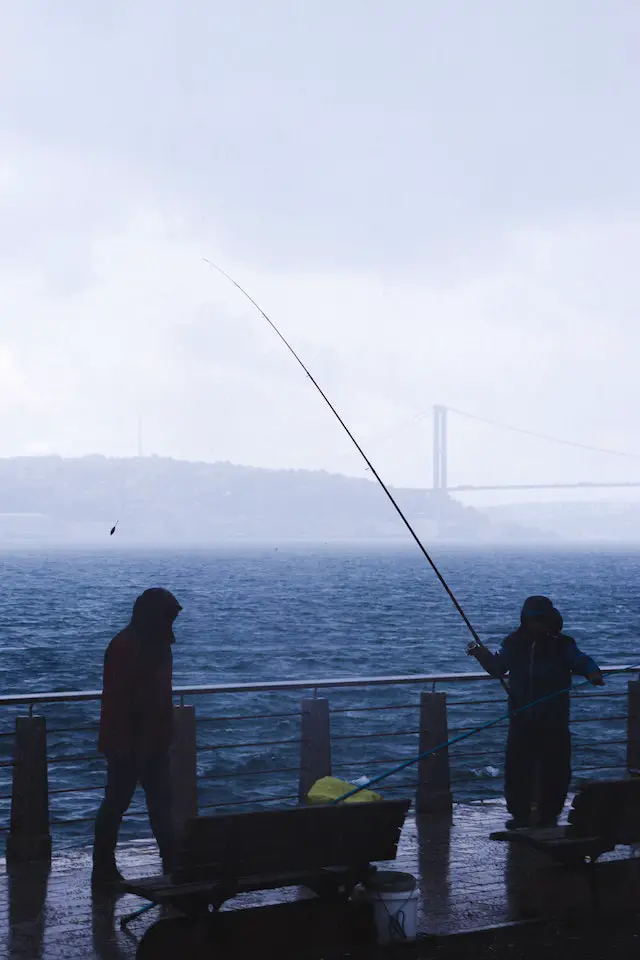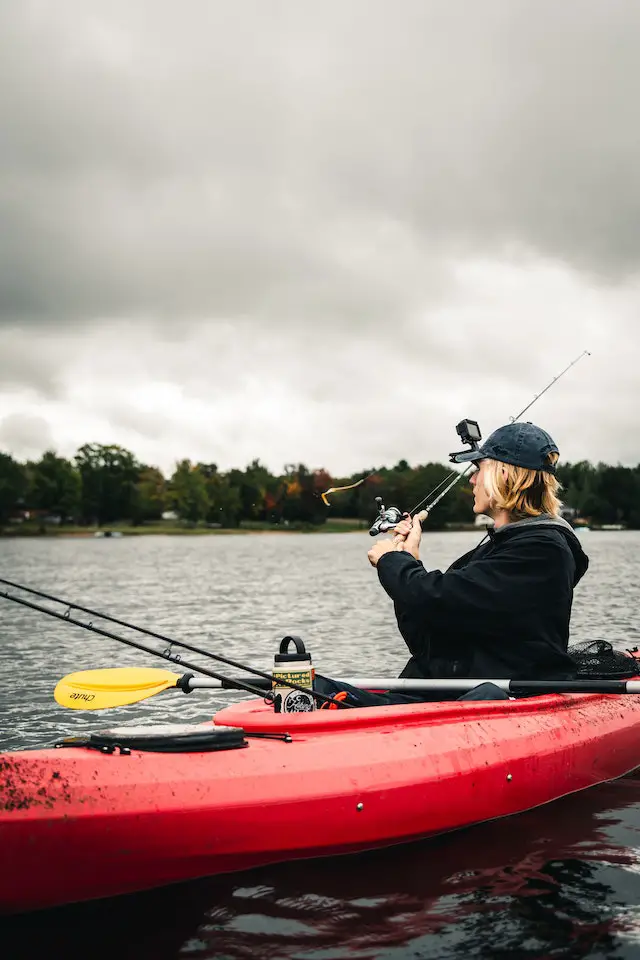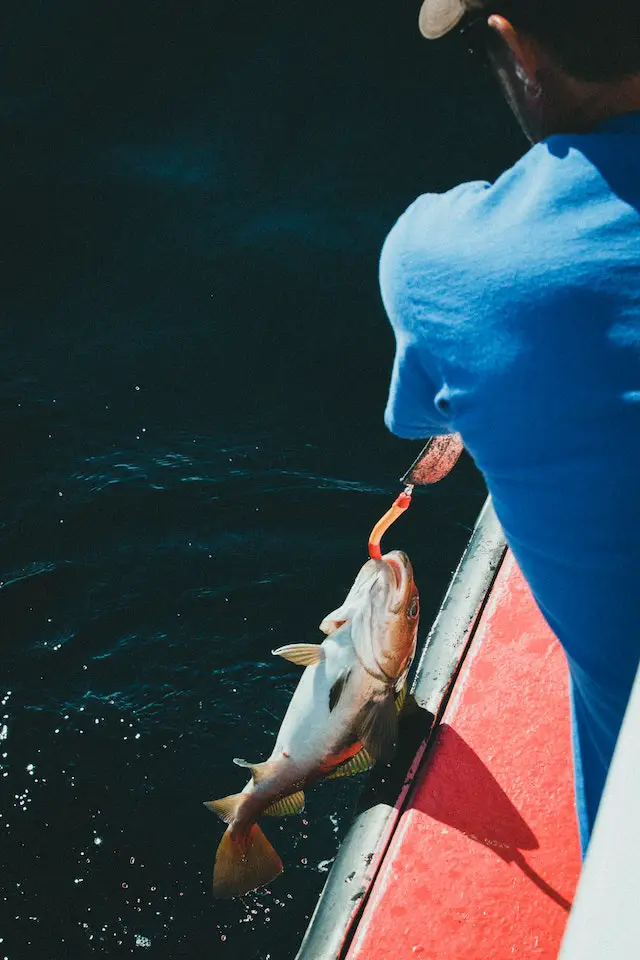Bass behavior is greatly affected by weather changes. Hence, to have a triumphant bass fishing adventure, you must consider weather conditions like precipitation, air temperature, wind speed, and barometric pressure.
As you can see, this subject is rather complex. It is thus better to go step by step in learning how different weather conditions can affect bass fishing.
In this post, we’ll deal with bass fishing after a rain and try to find out how these popular predatory fish behave in rainy weather or a heavy rain storm.
The main goal is to discover whether it is better to go fishing in the rain or wait patiently and go fishing after the rain. Stay tuned to the very end of this article – your bass fishing success might depend on it!
How Does Weather Impact Bass Fishing?

Weather can improve your chances of successful bass fishing if you learn how to use it to your advantage. So, let’s dig into it!
Bass Fishing Before A Rain Storm
Bass are typically very active just before a storm. Therefore, if you go out fishing at this time, you might improve your hook rate.
When storm fronts approach, the air pressure drops, and the sky darkens. High humidity and low barometric pressure drive bass into a feeding frenzy – don’t miss out on it! It might be the most productive bass fishing trip you have ever had.
Bass Fishing After A Rain Storm
What happens when the storm passes?
Unfortunately, all good things come to an end, and so does the pre-storm fish feeding frenzy. If you go back to the same fishing spot after the storm, you’ll probably end up disappointed. The bass that have been biting like crazy just a short time ago will now be hesitant and unwilling to chase after your bait.
But this doesn’t mean post-storm bass fishing is not possible. With a little bit of know-how, you can have success at catching bass after a rain storm too.
What Are The Best Areas For Bass Fishing After Rain?

Is bass fishing good after the storm? Is it worth your while?
It can be. Yet, fishing after a rain, especially heavy rain, comes with many challenges. After a strong storm with cold rain, the water temperature drops, and small fish remain dormant. Bass tend to do the same. They become lethargic, making it much harder for you to get a bite.
Powerful storms and heavy rains drive bass from their usual habitats. Hence, as your first step, you must find these elusive fish. You can use a fish finder or try to do it the old way.
The good news is that bass rarely travel a long distance. They won’t risk going too far as that would require expanding resources and a lot of energy-absorbent wandering. Hence, bass usually move just enough to feel safe again.
Before the rain (or even during it), bass roam the flats and grass beds packed with prey fish. They often risk coming out in the open too. However, as soon as the sky and muddy water clear, bass move into deeper areas nearest to their original dwelling.
For this reason, if you hope to catch fish during heavy rain and stormy weather, or immediately after it, you should concentrate on fishing deeper water and the closest drop-offs and ledges in that area.
In rainy weather, bass do the contrary to what they normally do – they move further away from underwater structures and heavy cover. So, do not waste your time there.
Where else to look?
Right after heavy rain, water clarity is bound to decrease. At such times, you should locate mud lines that form when the runoff water pours into the main body of water. These spots are quite turbulent and thus contain more oxygen too. Hence, to find active bass in muddy water, find the nearest runoff area first.
You can also take advantage of feeder creeks. Namely, once the rain storm starts, local feeder creeks rise due to sudden runoff from the surrounding land. They undergo big changes (melting snow has a similar effect).
The runoff areas near these creek mouths are a buffet for baitfish, panfish, and even small bass. They move in to feed on all the insects that the rain has washed into the water. Since rain brings oxygen (and lowers water temperatures during the hot season), these fish receive a boost of energy, too.
Big bass do not join them, but they are not far away from the action either. Most often, bass will patiently wait in deeper water closest to these creek mouths and gulp on the smaller fish who’ve come here to feed.
What Lures Should You Use When Bass Fishing After Rain?

Once you find bass, you must determine which lure and presentation to use to encourage post-rain bass activity and trigger more bites. The following advice will help you figure out the best solution.
As we have already established, bass after rain are often quite lethargic and uninterested in chasing lures. They usually enjoy their time resting, but it does not mean they are willing to miss out on an easy meal.
Forget about fast-moving lures. Instead, slow down and drop a temping soft-plastic bait right in front of dormant bass. They won’t be able to resist!
Also, adjust your tactic to the newly-created, post-rain conditions. If you hope to catch fish immediately after heavy rain, switch up your lures and presentation to match the water color.
The Best Post-Rain Bass Lures In Low-Visibility Conditions
Rain gathers the dirt and debris from the shore and washes it into rivers and lakes. Of course, this dirty runoff water causes quite a bit of turbulence, too. As a result, the water in the newly flooded areas becomes quite muddy.
Clouded water enables you to get close to the bass without being detected. However, bass that cannot see you cannot see your lure or bait either.
So, what is the solution?
When fishing during or after heavy rain, use a bright-colored lure or bait. In this way, you will create excellent contrast between your presentation and dark muddy water. The list of best vibrant colors to use in low visibility conditions includes:
- Yellow
- Bright red
- Pink
- Orange
- Lime green
- Green pumpkin
- Bright chartreuse
As an alternative, you can choose a very dark solid color, especially for slow-moving lures or soft plastic baits. It will maximize your profile’s visibility while maintaining a more natural appearance.
Check out the following video for more advice on fishing in muddy water:
The Best Post-Rain Bass Lures In High-Visibility Conditions
The water clarity and weather conditions can change in a nick of time. If the visibility in the water increases, you should best present lures with natural colors. Opt for the following colors when fishing clear water:
- Light blue
- White
- Light green
- Light brown
- Grey
Extra Advice: Fishing after a rain is highly-popular among anglers, and you can thus have a lot of competition. If you want to make sure you draw enough attention, choose a bait that creates vibrations or rattling sounds, such as a crankbait or chatterbait. They are great for night fishing too!
The Best Tips For Bass Fishing After Rain

Now that you know where to find bass and what lure to bring when fishing after a rain, all you lack are a few extra tips, and you can go out to catch fish and have fun! So, here they are!
Be Patient & Persistent
Unlike the pre-storm bass, post-storm bass are quite lethargic and reluctant to feed. Consequently, you must be patient and persistent. It might take you quite a few casts to the same area (sometimes even more than 10) before you finally get a bite.
Take A Pause
Try making long pauses while retrieving your bait. Do not hesitate to let your bait stay motionless for as long as 10 or 15 seconds, especially if it is a jig or a soft-plastic lure. This has proven to be a productive tactic for catching a lethargic post-rain bass with jerk baits, too.
Adjust To Sudden Weather Changes & Always Consider Safety First
You might be eager to get back to your favorite bass fishing spot after the rain storm – most anglers do. However, make sure you consider whether it is safe for you to go out or not.
Sometimes, there are bands of rain trailing the principal storm system. Although these bands bring more bad weather, they are not always a danger for anglers on the water.
If you are bass fishing during the fall or spring season, you will only get wet. However, during summer, the combination of high pressure, temperature, and humidity can induce sudden violent storms with high winds and lightning. To avoid danger (especially if you are on a boat), retreat to a safe place and wait for better weather conditions.
Go With The Flow
Heavy rains dump a lot of extra water in a river or a lake, increasing the strength and speed of the water currents. Bass cannot stay indifferent to these changes, and thus neither should you.
The post-rain flood drives bass behind current breaks. It is the ideal place for them to rest and ambush passing bait fish.
You should position yourself or your boat downstream of structures that break the current (points, bridge piles, etc.) and cast your lure upstream. Once you do that, retrieve the bait past the structure as slowly as possible – it is bound to trigger a bite!
Gear Up
If you want to get out on the water during rain or immediately after it, you need clothes that is guaranteed to keep you dry. Opt for quick-drying, water-repellent apparel made from rubber or Goretex and a high-quality fishing hat. Waterproof boots are a must!
Unfortunately, your rain jacket cannot keep your bass fishing rod or tackle box from getting wet. Hence, to make sure your equipment functions properly, leave it out to dry in between your fishing adventures.
Match Your Retrieve Rate To Current Water Temperature
Rain often changes the water temperature of a lake, pond, creek, or river (especially in shallow water). Cool rain during the hot summer season, or warm rain during late winter or early spring, can make the water temperature more comfortable for the local bass, stimulating their appetite and activity.
You should try to adjust your retrieve rate in accordance with the water temperature, too. It means you should fish faster in warmer water and slower in a cold one.
Watch a video below for advice on fishing in the rain:
FAQs
Do bass bite after it rains?
Bass bite after it rains as long as you adjust your fishing tactics and use appropriate fishing equipment and lures. Forget about fast-moving lures – fish slowly and patiently, and you will get a bite.
Is bass fishing better before or after rain?
Bass fishing is better before the rain. However, you can also have a lot of success fishing after a rain storm, as long as you are tenacious and follow a few simple rules.
Where do bass go when it rains?
When it rains, bass go to deeper waters and linger there for a while. They stay away from major structures and heavy cover too. The best place to look for them is on the closest drop-off or ledge.
Does rain affect bass fishing?
Rain does affect bass fishing. It can make fish active or lethargic, depending on the time of the year. During hot summer, cool rain can increase oxygen levels and spur up bass activity. Yet, for the rest of the year, rain has the opposite effect and makes bass less active.
Final Thoughts

So, is bass fishing good after rain or not?
It’s challenging! Catching a fish after a rain storm is never as easy as catching it just before the storm starts. However, experienced anglers often have success doing it. Try to apply everything you have just read, and you might also catch bass after rain and share their joy!
Feel free to ask me anything, and do not hesitate to go bass fishing as soon as the rain stops. You know how to do it now, don’t you?
